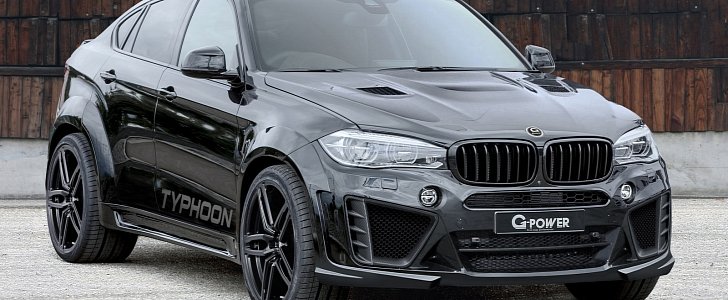German tuners at G-Power have unveiled their new “Typhoon” kit for the BMW X6M. In case the performance SUV from BMW did not have enough power, or a look that is aggressive enough for its customers, G-Power steps in with a kit that will surely not let you go unnoticed.
The second generation of the BMW X6M, called F86 in Munich’s textbooks, starts off with 575 HP. You would think that it is enough, but the specialists from Aresing know you are so wrong, and developed a 750 HP kit for the X6M.
The maximum torque has been increased to 980 Nm (722 lb-ft), for good measure. The enhanced resources are set to the road through a set of 23-inch wheels, equipped with performance tires.
As the tuner explains, they raised the power level of the V8 twin-turbo unit with the aid of CNC machined components, including a set of new turbine blades. The German company claims the uprated turbochargers provide a higher flow rate and better response.
Once the boost part of the equation is resolved, the tuners fitted their G-Power Bi-Tronik 2 V3 engine software, which operates without eliminating standard engine protection thresholds. We also know that the speed limiter has been removed, and that the tuned X6M has a top speed higher than 300 km/h (124 mph), while also achieving a quarter mile (402 meters) time of 11.5 seconds.
In case someone imagined the X6M was a sleeper, an aerodynamic kit has been developed. G-Power’s new Typhoon kit follows the tradition started by its predecessor and brings an aggressive look for BMW’s bold SUV.
The kit includes new aprons for the front and rear bumpers, fender flares, a carbon-fiber hood, and multiple ornaments made out of the pricey material. The package is rounded off (pun intended) with a set of four tailpipes, split into pairs of two, each with a 102-millimeter (four inches) diameter. They are linked to the engine through titanium pipes.
The maximum torque has been increased to 980 Nm (722 lb-ft), for good measure. The enhanced resources are set to the road through a set of 23-inch wheels, equipped with performance tires.
As the tuner explains, they raised the power level of the V8 twin-turbo unit with the aid of CNC machined components, including a set of new turbine blades. The German company claims the uprated turbochargers provide a higher flow rate and better response.
Once the boost part of the equation is resolved, the tuners fitted their G-Power Bi-Tronik 2 V3 engine software, which operates without eliminating standard engine protection thresholds. We also know that the speed limiter has been removed, and that the tuned X6M has a top speed higher than 300 km/h (124 mph), while also achieving a quarter mile (402 meters) time of 11.5 seconds.
In case someone imagined the X6M was a sleeper, an aerodynamic kit has been developed. G-Power’s new Typhoon kit follows the tradition started by its predecessor and brings an aggressive look for BMW’s bold SUV.
The kit includes new aprons for the front and rear bumpers, fender flares, a carbon-fiber hood, and multiple ornaments made out of the pricey material. The package is rounded off (pun intended) with a set of four tailpipes, split into pairs of two, each with a 102-millimeter (four inches) diameter. They are linked to the engine through titanium pipes.






